User:John K/Persian Empire
 |
| History of Greater Iran |
|---|
Persian Empire is a term used by scholars of the ancient, medieval, and modern history of Iran and the Near East to refer to various consecutive and non-consecutive dynastic states centred around the Iranian plateau, as well as their territories and domains of cultural and political influence.
The first Persian Empire formed under the Achaemenid dynasty (550–330 BC). The Achaemenid Empire (550–330 BC) was the largest empire of the ancient world and it reached its greatest extent under Darius the Great and Xerxes the Great — famous in antiquity as the foe of the classical Greek states (See Greco-Persian Wars). Arising from the region now known as Fars Province of Iran, at its height the Achaemenid Empire ruled over Greater Iran, Anatolia, Mesopotamia, the Levant, and Egypt, as well as some territories in Europe and the Aegean Sea. The Achaemenid Empire was conquered by Alexander the Great in 334-330 BC. For the next 550 years, most of Iran was ruled first by the descendants of Alexander's Macedonian general Seleucus I Nicator, who founded the Seleucid dynasty, and then by the Parthian Arsacid Dynasty.
The Sassanid dynasty, which replaced the Arsacids in 226 AD, arose from the same region as the Achaemenids, and restored the conception of a Persian Empire. Due to Roman power in the Mediterranean, their area of rule was more limited than that of the Achaemenids, being generally restricted to Greater Iran and Mesopotamia. They ruled until the Arab conquest in the mid 7th century.
After the Abbasid dynasty took power in the mid-8th century and moved their capital to Baghdad, in Mesopotamia on the Tigris river near the old Sassanid capital of Ctesiphon, the Islamic Caliphate gradually became Persianized. When the Abbasid dynasty began to break up in the late 9th century, regional Iranian dynasties arose, many of them claiming a connection to the Sassanids and professing ambitions to restore the old Persian Empire. Later Islamic dynasties in Iran, whether of Iranian, Turkic, or Mongol origins, also sought to claim ties to the ancient Persian Empire. In the sixteenth century, the Safavid dynasty took power in Iran, and, after a period of division, reunified the country under their rule. While the country they ruled was most commonly known as simply "Persia" in the west, the term "Persian Empire," by analogy with the ancient dynasties that ruled over the same territory, was occasionally used.
History[edit]
The Achaemenid Empire (550 BC–330 BC)[edit]
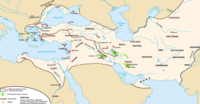

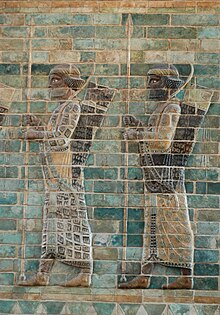
The earliest known record of the Persians comes from an Assyrian inscription from c. 844 BC that calls them the Parsu (Parsuaš, Parsumaš)[1] and mentions them in the region of Lake Urmia alongside another group, the Mādāyu (Medes).[2] For the next two centuries, the Persians and Medes were at times tributary to the Assyrians. The region of Parsuash was annexed by Sargon of Assyria around 719 BC. Eventually the Medes came to rule an independent Median Empire, and the Persians were subject to them.
The Achaemenids were the first to create a centralized state in Persia, founded by Achaemenes (Haxamaniš), chieftain of the Persians around 700 BC.
Around 653 BC, the Medes came under the domination of the Scythians, and Teispes (Cišpiš), the son of Achaemenes, seems to have led the nomadic Persians to settle in southern Iran around this time — eventually establishing the first organized Persian state in the important region of Anšan as the Elamite kingdom was permanently destroyed by the Assyrian ruler Ashurbanipal (640 BC). The kingdom of Anšan and its successors continued to use Elamite as an official language for quite some time after this, although the new dynasts spoke Persian, an Indo-Iranian tongue.
Teispes' descendants may have branched off into two lines, one line ruling in Anshan, while the other ruled the rest of Persia. Cyrus II the Great (Kuruš) united the separate kingdoms around 559 BC. At this time, the Persians were still tributary to the Median Empire ruled by Astyages. Cyrus rallied the Persians together, and in 550 BC defeated the forces of Astyages, who was then captured by his own nobles and turned over to the triumphant Cyrus, now Shah of a unified Persian kingdom. As Persia assumed control over the rest of Media and their large empire, Cyrus led the united Medes and Persians to still more conquest. He took Lydia in Asia Minor, and carried his arms eastward into central Asia. Finally in 539 BC, Cyrus marched triumphantly into the ancient city of Babylon. After this victory, he issued the declaration recorded in the Cyrus cylinder, which portrayed him as a benevolent conqueror welcomed by the local inhabitants and their gods.[3] Cyrus was killed in 530 BC during a battle against the Massagetae or Sakas.
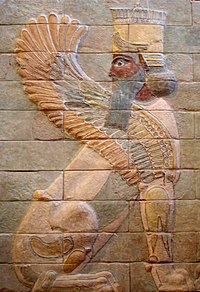
Cyrus's son, Cambyses II (Kambūjiya), annexed Egypt to the Achaemenid Empire. The empire then reached its greatest extent under Darius I (Dāryavuš). He led conquering armies into the Indus River valley and into Thrace in Europe. A punitive raid against Greece was halted at the Battle of Marathon. A larger invasion by his son, Xerxes I (Xšayārša), would have initial success at the Battle of Thermopylae. Following the destruction of his navy at the Battle of Salamis, Xerxes would withdraw most of his forces from Greece. The remnant of his army in Greece commanded by General Mardonius was ultimately defeated at the Battle of Plataea in 479 BC.
Darius improved the famous Royal Road and other ancient trade routes, thereby connecting far reaches of the empire. He may have moved the administration center from Fars itself to Susa, near Babylon and closer to the center of the realm. The Persians allowed local cultures to survive, following the precedent set by Cyrus the Great. This was not only good for the empire's subjects, but ultimately benefited the Achaemenids, because the conquered peoples felt no need to revolt.
It may have been during the Achaemenid period that Zoroastrianism reached South-Western Iran, where it came to be accepted by the rulers and through them became a defining element of Persian culture. The religion was not only accompanied by a formalization of the concepts and divinities of the traditional (Indo-)Iranian pantheon, but also introduced several novel ideas, including that of free will, which is arguably Zoroaster's greatest contribution to religious philosophy. Under the patronage of the Achaemenid kings, and later as the de-facto religion of the state, Zoroastrianism would reach all corners of the empire. In turn, Zoroastrianism would be subject to the first syncretic influences, in particular from the Semitic lands to the west, from which the divinities of the religion would gain astral and planetary aspects and from where the temple cult originates. It was also during the Achaemenid era that the sacerdotal Magi would exert their influence on the religion, introducing many of the practices that are today identified as typically Zoroastrian, but also introducing doctrinal modifications that are today considered to be revocations of the original teachings of the prophet.
The Achaemenid Empire united people and kingdoms from every major civilization in south West Asia and North East Africa. It was overthrown during the Wars of Alexander the Great.
The Sassanid Empire (226–651)[edit]
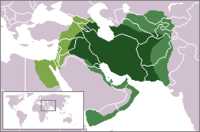
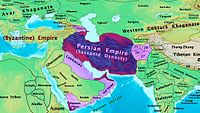
The Sassanid Empire or Sassanian Dynasty (Persian: ساسانیان) is the name used for the fourth imperial Iranian dynasty, and the second Persian Empire (226–651). The Sassanid dynasty was founded by Ardashir I (Persian: اردشیر یکم) after defeating the last Parthian (Arsacid) king, Artabanus V (Persian: اردوان پنجم Ardavan) and ended when the last Sassanid Shahanshah (King of Kings), Yazdegerd III (632–651), lost a 14-year struggle to drive out the early Islamic Caliphate, the first of the Islamic empires.
Ardashir I led a rebellion against the Parthian Confederacy in an attempt to revive the glory of the previous empire and to legitimize the Hellenized form of Zoroastrianism practised in southwestern Iran. In two years he was the Shah of a new Persian Empire.
The Sassanid dynasty (also Sassanian, named for Ardashir's grandfather) was the first dynasty native to the Pars province since the Achaemenids; thus they saw themselves as the successors of Darius and Cyrus. They pursued an aggressive expansionist policy. They recovered much of the eastern lands that the Kushans had taken in the Parthian period. The Sassanids continued to make war against Rome; a Persian army even captured the Roman Emperor Valerian in 260.
The Sassanid Empire, unlike Parthia, was a highly centralized state. The people were rigidly organized into a caste system: Priests, Soldiers, Scribes, and Commoners. Zoroastrianism was finally made the official state religion, and spread outside Persia proper and out into the provinces. There was sporadic persecution of other religions. The Eastern Orthodox Church was particularly persecuted, but this was in part due to its ties to the Roman Empire. The Nestorian Christian church was tolerated and sometimes even favored by the Sassanids.

The wars and religious control that had fueled the Sassanid Empire's early successes eventually contributed to its decline. The eastern regions were conquered by the White Huns in the late 5th century. Adherents of a radical religious sect, the Mazdakites, revolted around the same time. Khosrau I was able to recover his empire and expand into the Christian countries of Antioch and Yemen. Between 605 and 629, Sassanids successfully annexed Levant and Roman Egypt and pushed into Anatolia.
However, a subsequent war with the Romans utterly destroyed the empire. In the course of the protracted conflict, Sassinid armies reached Constantinople, but could not defeat the Byzantines there. Meanwhile, the Byzantine Emperor Heraclius had successfully outflanked the Persian armies in Asia Minor and attacked the empire from the rear while the main Iranian army along with its top Eran Spahbods were far from battlefields. This resulted in a crushing defeat for the Sassanids in Northern Mesopotamia. The Sassanids had to give up all their conquered lands and retreat.
Following the advent of Islam and collapse of the Sassanid Empire, Persians came under the subjection of Arab rulers for almost two centuries before native Persian dynasties could gradually drive them out. In this period a number of small and numerically inferior Arab tribes migrated to inland Iran.[4]
Also some Turkic tribes settled in Persia between the 9th and 12th centuries.[5]
In time these peoples were integrated into numerous Persian populations and adopted Persian culture and language while Persians retained their culture with minimal influence from outside.[6]
Arabs, Turks, and Mongols (643-1500)[edit]

The explosive growth of the Arab Caliphate coincided with the chaos caused by the defeat of Sassanids in wars with the Byzantine Empire. Most of the country was conquered between 643 and 650 with the Battle of Nihawand marking the total collapse of the Sassanids.[7] Arabs defeated Persians and other Iranians and introduced their religion.
Yazdgerd III, the last Sassanid emperor, died ten years after he lost his empire to the newly-formed Muslim Caliphate. He tried to recover some of what he lost with the help of the Turks, but they were easily defeated by Muslim armies. Then he sought the aid of the Chinese Tang dynasty. However, the Chinese never intervened on behalf of the Sassanids and instead, appointed Peroz, son of Yazdgerd as the governor over his own territory which the Tang named the "protectorate of Persia". This territory was overrun by the Arabs around the early 660s and Peroz escaped to the Tang court. The Umayyads would rule Persia for a hundred years. The Arab conquest dramatically changed life in Persia. Arabic became the new lingua franca, Islam eventually replaced Zoroastrianism, and mosques were built.
In 750 the Umayyads were ousted from power by the Abbasid dynasty. Under the Abbasids, who moved their capital from Damascus to Baghdad, near the old Sassanid capital of Ctesiphon, Persians came to play an important role in the bureaucracy of the empire.[8] In the early ninth century, the caliph Al-Ma'mun, whose mother was Persian, moved his capital away from Arab lands into Merv in eastern Iran.
Beginning in the ninth century, the Abbasid power began to collapse, and power fell into the hands of a series of regional dynasties. In Iran, these dynasties included the Tahirid dynasty, the Saffarid dynasty, the Ziyarid dynasty, the Samanid dynasty, and the Buyid dynasty. Although these dynasties were all Muslim, they were largely of Iranian origin, and to various extents sought to tie themselves to the Sassanid or Achaemenid heritage; some toyed explicitly with the idea of a restoration of a "Persian Empire" under their own rule, although none was successful in even unifying the whole of the Iranian plateau.
This was accomplished instead by the Turkic Seljuq dynasty, which in the second half of the eleventh century established its rule over virtually the whole territory of the old Achaemenid empire, with the exception of Egypt. The Seljuq sultans quickly became Persianized, and used Persian titles and court ceremonial, but their empire is almost never referred to as "the Persian Empire." It quickly broke up after the death of Malik Shah in 1092.
The Iranian plateau would not be unified again until the arrival of the Mongols who overran Iran and most of the rest of the Middle East in the mid-thirteenth century. The Ilkhanate which they established in Tabriz in 1256 ruled over most of Iran, but as foreign conquerors - they did not convert to Islam until the end of the thirteenth century. Europeans and older scholarship occasionally refer to the Ilkhanate as the "Persian Empire," although this usage is unusual. After the break-up of the Ilkhanate in the early fourteenth century came a long period of disunity, broken by the establishment and break-up of the empire of Timur and his descendants in the late fourteenth and early fifteen centuries.
The Safavids and after (1501-1979)[edit]
A new Persian Empire was established by the Safavid dynasty, who reunified Iran in the early sixteenth century. The Safavids hailed from the town of Ardabil in the region of Azarbaijan. The Safavid Shah Ismail I overthrew the White Sheep (Akkoyunlu) Turkish rulers of Persia to found a new native Persian empire. Ismail expanded Persia to include all of present-day Azerbaijan, Iran, and Iraq, plus much of Afghanistan and Pakistan. Ismail's expansion was halted by the Ottoman Empire at the Battle of Chaldiran in 1514, and war with the Ottomans became a fact of life in Safavid Iran.
Safavid Persia was a violent and chaotic state for the next seventy years, but in 1588 Shah Abbas I of Persia ascended to the throne and instituted a cultural and political renaissance. He moved his capital to Isfahan, which quickly became one of the most important cultural centers in the Islamic world. He made peace with the Ottomans. He reformed the army, drove the Uzbeks out of Iran and into modern-day Uzbekistan, and (with English help) recaptured the island of Hormuz from the Portuguese.
The Safavids were followers of Shi'a Islam, and under them Persia (Iran) became the largest Shi'a country in the Muslim world, a position Iran still holds today.
Under the Safavids Persia enjoyed its last period as a major imperial power. In 1639, a final border was agreed upon with the Ottoman Empire with the Treaty of Qasr-e Shirin; which delineates the border between the Republic of Turkey and Iran and also that of between Iraq and Iran, today.
In 1722, the Safavid state collapsed. That year saw the first European invasion of Persia since the time of Heraclius: Peter the Great, Emperor of Imperial Russia, invaded from the northwest as part of a bid to dominate central Asia. Ottoman forces accompanied the Russians, successfully laying siege to Isfahan.
The Russians conquered the city of Baku and its surroundings. The Turks also gained territory. However, the Safavids were severely weakened, and that same year (1722), the Afghans launched a bloody battle in response to the Safavids' attempts on trying to forcefully convert them from Sunni to Shi'a sect of Islam. The Safavid shah was executed, and although the dynasty would be restored a few years later, it never regained its lost authority.
Nadir Shah, who usurped the crown from the Safavids in 1736 and established the Afsharid dynasty, was able to renew Persian power in the 1730s and 1740s. Nadir checked the advances of the Russians and defeated the Afghans, later recapturing all of Afghanistan. He also launched successful campaigns against the nomadic khanates of Central Asia, and the Arabs of Oman. He also recaptured the territories lost to the Ottomans and invaded the Ottoman Empire. In 1739, he attacked and looted Delhi, the capital of Moghul India. After Nadir Shah was assassinated, Iran again fell into disunity, with the Luri Zand dynasty eventually securing control, only to itself fall prey to civil war and fall in 1794.
Persia found relative stability in the Qajar dynasty, which ruled for most of the nineteenth century, but by the late nineteenth century increasingly found itself falling prey to the influence of the European powers. In the early twentieth century, the army officer Reza Khan overthrew the Qajars and established the Pahlavi dynasty, which would be the last dynasty to rule the country. In 1935 Reza Pahlavi insisted that foreign powers, which had previously referred to the country as Persia, instead call it Iran.
Reza Pahlavi's son, Mohammad Reza Pahlavi, was the last Shah of Iran. He sought to emphasize his connections with the dynasties which had ruled in ancient times, celebrating the 2500th anniversary of the establishment of the Persia Empire in a massive ceremony at Persepolis in 1971. Soon after, he was overthrown by the Iranian Revolution of 1979, which resulted in the establishment of the Islamic Republic of Iran, and the end of monarchy in the country.
See also[edit]
- Iran
- Greater Iran
- History of Iran
- Persianate society
- Persianization
- List of kings of Persia
- Capitals of Persia
- Shah
References[edit]
- Stronach, David "Darius at Pasargadae: A Neglected Source for the History of Early Persia," Topoi
- Abdolhossein Zarinkoob, Ruzgaran: tarikh-i Iran az aghz ta saqut saltnat Pahlvi Sukhan, 1999. ISBN 964-6961-11-8
- Ali Akbar Sarfaraz, Bahman Firuzmandi Mad, Hakhamanishi, Ashkani, Sasani, Marlik, 1996. ISBN 964-90495-1-7
- Daniel, Elton, The History of Iran, Greenwood Press, 2001
- Iran Chamber Society (History of Iran)
Notes[edit]
- ^ Hammond, N. G. L. (1988-11-24). The Cambridge Ancient History Set: The Cambridge Ancient History Volume 4: Persia, Greece and the Western Mediterranean, c.525-479 BC: Persia, Greece and ... C.525-479 B.C. Ed.J.Boardman, Etc v. 4. John Boardman, D. M. Lewis (eds.) (2 ed.). Cambridge University Press. p. 15. ISBN 0521228042.
{{cite book}}: Unknown parameter|coauthors=ignored (|author=suggested) (help) - ^ Parpola, Simo. "Assyrian Identity in Ancient Times and Today" (PDF). Assyriology. Journal of Assyrian Academic Studies. p. 3.
Ethnonyms like Arbāyu "Arab", Mādāyu "Mede", Muşurāyu "Egyptian", and Urarţāyu "Urartian" are from the late eighth century on frequently borne by fully Assyrianized, affluent individuals in high positions.
- ^ Pierre Briant "Cyrus the Great" The Oxford Companion to Classical Civilization. Ed. Simon Hornblower and Antony Spawforth. Oxford University Press, 1998.
- ^ Zarinkoob, pp. 355-357
- ^ Zarinkoob, pp. 461, 519
- ^ Zarinkoob, p. 899
- ^ A Short History of Syriac Literature By William Wright. pg 44
- ^ ISBN 1-84212-011-5
Further reading[edit]
- Bailey, Harold (ed.) The Cambridge History of Iran, Cambridge University Press 1993, Cambridge. ISBN 0-521-45148-5
- Wiesehofer, Josef: Ancient Persia
- J. E Curtis and N. Tallis: Forgotten Empire: The World of Ancient Persia
- Pierre Briant: From Cyrus to Alexander: A History of the Persian Empire, Eisenbrauns: 2002, ISBN 978-1-57506-0310 Parameter error in {{ISBN}}: checksum
- Richard N. Frye: The Heritage of Persia
- A.T. Olmstead: History of the Persian Empire
- Lindsay Allen: The Persian Empire
- J.M. Cook: The Persian Empire
- Tom Holland: Persian Fire: The First World Empire and the Battle for the West
- Amini Sam: Pictorial History of Iran: Ancient Persia Before Islam 15000 B.C.-625 A.D.
- Timelife Persians: Masters of the Empire (Lost Civilizations)
- Farrokh, Kaveh: Shadows in the Desert: Ancient Persia at War, Osprey: 2007, ISBN 978-1-84603-108-3
- Brosius, Maria: The Persians: An Introduction, Routledge:2006, ISBN 978-0-41532-090-0
- Wiesehofer, Joseph Ancient Persia New York:1996 I.B. Tauris
External links[edit]
- The Persian Empire
- Iran, The Forgotten Glory - Documentary Film About Ancient Iran (achaemenids & Sassanids)
- Iran before Iranians - Complete History of Persian Empire
- Iran’s Cultural Heritage News Agency (CHN)
- Persia, by S.G.W. Benjamin, 1891
- Iran Cultural Heritage Organization Documentation Center (Persian)
- Ancient History Sourcebook: Persia
- Iran Cultural Heritage Organization Technical Office for Preservation and Restoration (Persian)
- Iran Research Center for Conservation of Cultural Relics
- Persepolis Official website
- Persian Language (Persian)
- Oriental Institute Photographic Archives (Nearly 1,000 archaeological photographs of Persepolis and Ancient Persia)
- Hamid-Reza Hosseini, Shush at the foot of Louvre (Shush dar dāman-e Louvre), in Persian, Jadid Online, 10 March 2009, [1].
Audio slideshow: [2] (6 min 31 sec).
Category:History of Iran Category:Former empires Category:Former monarchies of Asia Category:Achaemenid Empire Category:Medes Category:Pre Islamic history of Afghanistan Category:History of Iraq Category:Persian-speaking countries and territories Category:Ancient Persia Category:Civilizations
